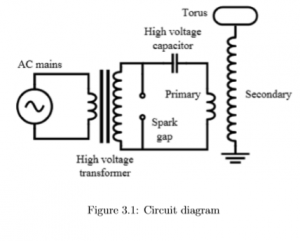Tesla coil is an electrical resonant transformer circuit invented and named after by Nicola Tesla
in 1891. It is used to produce high voltage, low current alternating current electricity. The output
voltage is produced by resonance. Tesla coil can be of different types based on the excitation it
uses that sparks excited Tesla coil, switched Tesla coil, continuous wave, etc. It is a radio
frequency oscillator with pulsed output. This is not only used for wireless power transmission
but for many commercial applications and there are spark-gap radio transmitters, induction, and
dielectric heating, induction coils, medical X-ray devices, quick medical devices, ozone
detectors, particle accelerators, electrical stage shows, and entertainment. Since he couldn’t
design the coil for long-range transmission, researches are still going on to light up his bold
and fascinating dream. If this was not found out by Tesla or other inventors, the term Witricity
would have been just a dream or an illusion. Tesla invented his Tesla coil around 1891 while he
was replicating and then expanding on Heinrich Hertz experiments. That was electromagnetic
radiation which was discovered 3 years earlier.
He decided to power his setup with the high-speed alternator he had been developing as part of an improved arc lighting system but found
that the high-frequency current overheated the iron core and melted the insulation between
primary and secondary windings. To fix this problem Tesla changed the design so that there was
an air gap instead of insulating material between the winding and made it so that the iron core
could be moved to different positions in or out of the coil.

Tesla coil is used to produce high voltage, low current alternating current electricity. The
principle behind the Tesla coil is to achieve a phenomenon called resonant inductive coupling that is
the wireless transmission of electrical energy between two magnetically coupled coils. This is a part
of resonant circuits tuned to resonate at the same frequency. This can be viewed in a resonant
transformer, an electrical device which encloses two high Q coils wound on the same core. It
also has capacitors connected across the windings to form two coupled LC circuits.
WORKING
The circuit operates in a rapid repeating cycle in which the supply transformer charges the capacitor
to a high voltage; which has low reactance. When the voltage across the capacitor reaches the
breakdown voltage of the spark gap, a spark bridge is formed. As a result spark gap resistance is
reduced to a very low value. This finishes the primary circuit. So the current from the capacitor
flows through the primary coil. The current flows rapidly back and forth between the plates of
the capacitor through coil generating radio frequency oscillating current in the primary circuit at
the circuits resonant frequency.
The oscillating magnetic field of the primary winding includes an oscillating current in the
secondary winding by Faraday’s law of induction. Over a number of cycles, the energy in the
primary circuit is transferred to the secondary. The total energy in the tuned circuits is limited to
the energy originally stored in the capacitor, so the oscillating voltage in the secondary increases
in amplitude and the oscillations in the primary decreases to zero. Because of small capacitance,
the oscillating voltage across the secondary coil which appears on the output terminal is much
larger than the primary voltage. The secondary current creates a magnitude field that is spread in
the surrounding atmosphere by the top load i.e toroid. The energy shifting process repeats rapidly
back and forth between the primary and secondary tuned circuits. The oscillating currents in the
primary and secondary gradually die out due to energy dissipated as heat in the spark gap and
resistance of the coil. Again the current from the supply transformer begins charging the
capacitor and this cycle repeats. Hence this entire cycle takes place very rapidly such that the
oscillations dying out in a time of the order of a millisecond. So the output is such that, a bulb
will glow if it is brought near to this circuit
